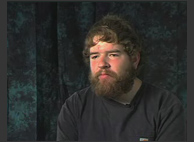| NIMH: Autism Spectrum Disorders | |
| NICHD: Autism and the MMR Vaccine | |
| Richard, Age 52 | |
| Jeff, Age 35 | |
| NIMH: Autism Spectrum Disorders (pdf) | |
| CDC: Learn the Signs Information Card (pdf) | |

Autism Spectrum Disorders (Pervasive Developmental Disorders)
Rare Autism Spectrum Disorders
Rett Syndrome
Rett syndrome is relatively rare, affecting almost exclusively females, one out of 10,000 to 15,000. After a period of normal development, sometime between 6 and 18 months, autism-like symptoms begin to appear. The little girl's mental and social development regresses—she no longer responds to her parents and pulls away from any social contact. If she has been talking, she stops; she cannot control her feet; she wrings her hands. Some of the problems associated with Rett syndrome can be treated. Physical, occupational, and speech therapy can help with problems of coordination, movement, and speech.
Scientists sponsored by the National Institute of Child Health and Human Development have discovered that a mutation in the sequence of a single gene can cause Rett syndrome. This discovery may help doctors slow or stop the progress of the syndrome. It may also lead to methods of screening for Rett syndrome, thus enabling doctors to start treating these children much sooner, and improving the quality of life these children experience.*
Childhood Disintegrative Disorder
Very few children who have an autism spectrum disorder (ASD) diagnosis meet the criteria for childhood disintegrative disorder (CDD). An estimate based on four surveys of ASD found fewer than two children per 100,000 with ASD could be classified as having CDD. This suggests that CDD is a very rare form of ASD. It has a strong male preponderance.** Symptoms may appear by age 2, but the average age of onset is between 3 and 4 years. Until this time, the child has age-appropriate skills in communication and social relationships. The long period of normal development before regression helps differentiate CDD from Rett syndrome.
The loss of such skills as vocabulary are more dramatic in CDD than they are in classical autism. The diagnosis requires extensive and pronounced losses involving motor, language, and social skills.*** CDD is also accompanied by loss of bowel and bladder control and oftentimes seizures and a very low IQ.
*Rett syndrome. NIH Publication No. 01-4960. Rockville, MD: National Institute of Child Health and Human Development, 2001. Available at http://www.nichd.nih.gov/publications/pubskey.cfm?from=autism
**Frombonne E. Prevalence of childhood disintegrative disorder. Autism, 2002; 6(2): 149-157.
***Volkmar RM and Rutter M. Childhood disintegrative disorder: Results of the DSM-IV autism field trial. Journal of the American Academy of Child and Adolescent Psychiatry, 1995; 34: 1092-1095.
NIH Publication No.04-5511
April 2004,
Addendum February 2007



